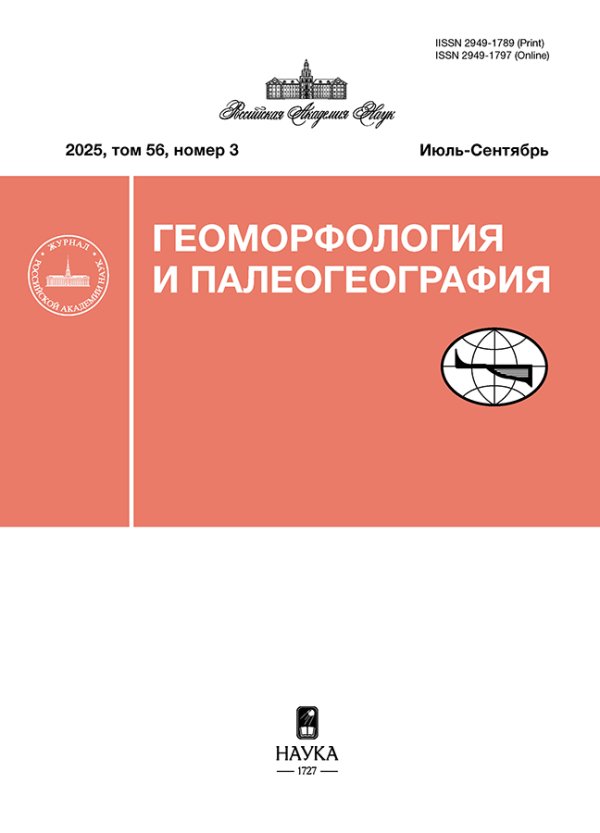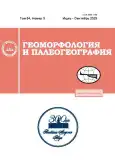DEBRIS FLOW RELIEF OF THE MALAYA PAIPUDYNA BASIN (THE POLAR URAL MOUNTAINS)1
- Authors: Rudinskaya A.I.1, Belyaev Y.R.2
-
Affiliations:
- Institute of Geography RAS
- Lomonosov Moscow State University, Faculty of Geography
- Issue: Vol 54, No 3 (2023)
- Pages: 14-25
- Section: SHORT COMMUNICATIONS
- URL: https://journals.rcsi.science/2949-1789/article/view/140580
- DOI: https://doi.org/10.31857/S2949178923030088
- EDN: https://elibrary.ru/WDKBWN
- ID: 140580
Cite item
Full Text
Abstract
We studied the debris flow relief of the Malaya Paipudyna basin, the Polar Ural Mountains. Based on the analysis of remote sensing data and field surveys, we established that 14 debris flow basins are located on the territory. We found traces of five slushflow occurrence in the streams in the spring of 2021. Typical landforms for different morphodynamic zones of debris flow basins were identified. The initiation zones of debris flows are mainly represented by catchment funnels on the slopes of the Bolshoi and Maliy PaIpudynskii ranges. The transit zones V-shaped bottom incisions alternate with box- and trough-shaped transverse profile. Within the debris flow fans, two generations of accumulative debris flow relief are clearly distinguished. Young accumulation zones are represented by pebble-boulder ridges up to 0.5 m high, localized directly in the near-channel areas of debris flow fans. Usually, they are either devoid of soil and vegetation cover, or are overgrown only by herbs. Ancient debris flow fans are triangular in shaped with convex transverse profile, consisting of a system of ridges and hollows, and overgrown with shrubs. The area of young accumulation zones for each debris flow basin is no more than 0.03 km2, the area of ancient accumulation zones is 0.4 km2. Debris flow fans are superimposed on the bottom of the trough valley of Malaya Paipudyna, which is mainly the surface of glacial accumulation. Probably, the formation of these fans began after the degradation of the last extensive glaciation of the territory. We calculated the morphometric features of the debris flow basins.
About the authors
A. I. Rudinskaya
Institute of Geography RAS
Author for correspondence.
Email: rudinskaya94@gmail.com
Russia, Moscow
Yu. R. Belyaev
Lomonosov Moscow State University, Faculty of Geography
Email: rudinskaya94@gmail.com
Russia, Moscow
References
- Anan’ev G.S. (1980). Geomorphological province of Novaja zemlja Island and the Ural Mountains. Geomorfologicheskoe raionirovanie SSSR i prilegayushchikh morei. Moscow: Vysshaya shkola (Publ.). P. 62–73. (in Russ.)
- Astakhov V. (2017). Late Quaternary glaciation of the northen Urals: a review and a new observations. Boreas. Vol. 47. P. 379–389. https://doi.org/10.1111/bor.12278
- Astakhov V.I. (2017). Novaya model' pleistotsenovogo oledeneniya na severe Urala (New model of the Pleistocene glaciation in the north Urals. Doklady akademii nauk. Vol. 476. No. 5. P. 567–570. (in Russ.). https://doi.org/10.7868/S0869565217290199
- Cherkasova V.A., Ivanov M.N. (2020). Degradation of the glaciers of the Polar Urals. Global’nye problemy Arktiki i Antarktiki [Electronic data]: sbornik nauch. materialov Vseros. konf. s mezhdunar. uchastiem, posvyashchennyi 90-letiyu so dnya rozhdeniya akademika N.P. Lavjorova. Arhangel’sk. P. 180–182. (in Russ.). (access date: 15.02.2023)
- Filosofov V.P., Denisov S.V. (1963). On the order of river valleys and their connection with tectonic. Morfometricheskii metod pri geologicheskikh issledovaniyakh. Saratov: Saratov University (Publ.). P. 487–509. (in Russ.)
- Garankina E., Belyaev V., Belyaev Yu. et al. (2019). Integration of landforms, deposits and paleosols analysis for reconstructing Holocene debris flow activity in the low mountains of Kola Peninsula. Climate Change Impacts on Sediment Dynamics: Measurement, Modelling and Management. Chalov S., Golosov V., Li R., Tsyplenkov A. (Eds.). Springer Proceedings in Earth and Environmental Sciences (SPEES). Cham: Springer. P. 47–51. https://doi.org/10.1007/978-3-030-03646-1_9
- Golubev G.N., Labutina I.A. (1966). Deciphration of high-mountain debris flows using aerial photographs. Vestnik Moskovskogo universiteta. Seriya 5. Geografiya. No. 1. P. 48–53. (in Russ.)
- Hodakov V.G. (1964). The processes of redistribution of snow and snow cover in the mountains. MGI. Vol. 9. Moscow: VINITI (Publ.). P. 210–215. (in Russ.)
- Hodakov V.G., Il’ina E.A. (1989). Snow and ice phenomena in the Polar Urals. MGI. Vol. 65. Moscow: VINITI (Publ.). P. 110–118. (in Russ.)
- Ivanov M.N. (2012). Polar Urals Glaciers and Periglacial Geomorphology. TICOP Excursion Guidebook. Tyumen: Pechatnik (Publ.). 50 p.
- Ivanov M.N. (2013). Evolyutsiya oledeneniya Polyarnogo Urala v pozdnem golotsene (Evolution of glaciation in the Polar Urals in the Late Holocene). Moscow: Geograficheskii fakul’tet MGU (Publ.). 200 p. (in Russ.)
- Kazak A.P. (Eds.). (2013). Gosudarstvennaya geologicheskaya karta Rossiiskoi Federatsii masshtaba 1: 200000. Karta dochetvertichnykh obrazovanii. List Q-41-XII (State geological map of the Russian Federation, scale 1:200 000. Map of pre-Quaternary formations. Sheet Q-41-XII). Saint-Petersburg: VSEGEI (Publ.). 1 p. (in Russ.)
- Mangerud J., Gosse J., Matiouchkov A., Dolvik T. (2008). Glaciers in the Polar Urals, Russia, were not much larger during the Last Global Glacial Maximum than today. Quaternary Science Reviews. No. 27. P. 100–115. https://doi.org/10.1016/j.quascirev.2008.01.015
- Meyer H., Kostrova S., Meister Ph. et al. (2022). Lacustrine diatom oxygen isotopes as palaeo precipitation proxy – Holocene environmental and snowmelt variations recorded at Lake Bolshoye Shchuchye, Polar Urals, Russia. Quaternary Science Reviews. Vol. 290. 107620. https://doi.org/10.1016/j.quascirev.2022.107620
- Perov V., Chernomorets S., Budarina O. et al. (2017). Debris flow hazards for mountain regions of Russia: regional features and key events. Natural Hazards. No. 88. P. 199–235. https://doi.org/10.1007/s11069-017-2841-3
- Perov V.F. (2012). Selevedenie (Mudflow science). Moscow: MGU (Publ.). 274 p. (in Russ.)
- Poznanin V.L. (1975). Debris flows of the Northen part of the Polar Urals. Izucheniie i ohrana gidrosfery. Moscow: MFGO (Publ.). P. 10–11. (in Russ.)
- Rudinskaya A.I., Belyaev Yu.R. (2022). Morphometric features of debris flow basins of the mountains. Izvestiya Rossiiskoi akademii nauk. Seriya geograficheskaya. No. 5. P. 746–752. https://doi.org/10.31857/S2587556622050107
- Rudinskaya A.I., Belyaev Yu.R., Belyaev V.R. et al. (2022). Geomorphologic positions of debris flow basins in the Lovozerskiye Tundry mountainous area. Vestnik Moskovskogo universiteta. Seriya 5. Geografiya. No. 2. P. 119–132. (in Russ.)
- Sadov A.V. (1972). Aerometody izucheniia selei (Aerial methods for studying debris flows). Moscow: Nedra (Publ.). 126 p. (in Russ.)
- Shishkin M.A. (2007). Assumed directions of movement of Neopleistocene glaciers in Pai-Khoi and the Polar Urals based on the analysis of the composition of moraine boulders. Regional’naya geologiya i metallogeniya. No. 30–31. P. 207–212. (in Russ.)
- Solomina O., Ivanov M., Bradwall T. (2010). Lichenometric studies on moraines in the Polar Urals. Geografiska Annaler. Series A, Physical Geography. Vol. 92. No. 1. P. 81–99.
- Surova T.G., Troickii L.S., Punning Ja.-M.K. (1974). Development of glaciation in the Polar Urals in the late Pleistocene and Holocene (in connection with the study of deposits of ice-dammed lakes). MGI. Hron., obs. Vol. 23. Moscow: VINITI (Publ.). C. 61–68. (in Russ.)
- Surova T.G., Troickij L.S., Punning Ja.-M. (1975). Paleogeography and absolute chronology of the Holocene of the Polar Urals. Izvestiya AN ESSR. Himiya, Geologiya. Vol. 24. No. 2. P. 152–159. (in Russ.)
- Svendsen J.I., Færseth L.M., Gyllencreutz R. et al. (2018). Glacial and environmental changes over the last 60 000 years in the Polar Ural Mountains, Arctic Russia, inferred from a high-resolution lake record and other observations from adjacent areas. Boreas. Vol. 48. No. 2. P. 407–431. https://doi.org/10.1111/bor.12356
- Svendsen J.I., Krüger L.C., Mangerud J. et al. (2014). Glacial and vegetation history of the Polar Ural Mountains in Northern Russia during the Last Ice Age, Marine Isotope Stages 5-2. Quaternary Science Reviews. Vol. 92. P. 409–428. https://doi.org/10.1111/j.1502-3885.2012.00269.x
- Svendsen J.I., Magnerud J., Nazarov D. et al. (2023). Chapter 16 – The Polar Ural Mountains: deglaciation history. European Glacial Landscapes. The Last Deglaciation. D. Palacios, J.M. García-Ruiz, Ph.D. Hughes, N. Andrés. (Eds.). P. 143–148. https://doi.org/10.1016/B978-0-323-91899-2.00053-X
Supplementary files














